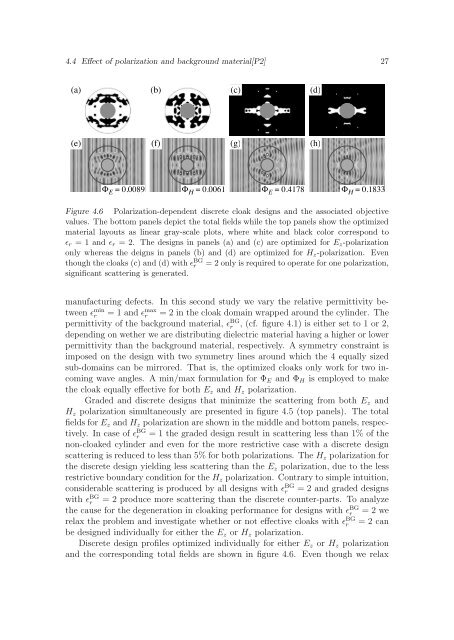Wave Manipulation by Topology Optimization - Solid Mechanics
Wave Manipulation by Topology Optimization - Solid Mechanics
Wave Manipulation by Topology Optimization - Solid Mechanics
Create successful ePaper yourself
Turn your PDF publications into a flip-book with our unique Google optimized e-Paper software.
4.4 Effect of polarization and background material[P2] 27<br />
<br />
<br />
<br />
<br />
<br />
<br />
Figure 4.6 Polarization-dependent discrete cloak designs and the associated objective<br />
values. The bottom panels depict the total fields while the top panels show the optimized<br />
material layouts as linear gray-scale plots, where white and black color correspond to<br />
ɛr =1andɛr = 2. The designs in panels (a) and (c) are optimized for Ez-polarization<br />
only whereas the deigns in panels (b) and (d) are optimized for Hz-polarization. Even<br />
though the cloaks (c) and (d) with ɛBG r = 2 only is required to operate for one polarization,<br />
significant scattering is generated.<br />
manufacturing defects. In this second study we vary the relative permittivity between<br />
ɛmin r =1andɛmax r = 2 in the cloak domain wrapped around the cylinder. The<br />
permittivity of the background material, ɛ BG<br />
r , (cf. figure 4.1) is either set to 1 or 2,<br />
depending on wether we are distributing dielectric material having a higher or lower<br />
permittivity than the background material, respectively. A symmetry constraint is<br />
imposed on the design with two symmetry lines around which the 4 equally sized<br />
sub-domains can be mirrored. That is, the optimized cloaks only work for two incoming<br />
wave angles. A min/max formulation for ΦE and ΦH is employed to make<br />
the cloak equally effective for both Ez and Hz polarization.<br />
Graded and discrete designs that minimize the scattering from both Ez and<br />
Hz polarization simultaneously are presented in figure 4.5 (top panels). The total<br />
fields for Ez and Hz polarization are shown in the middle and bottom panels, respec-<br />
tively. In case of ɛ BG<br />
r<br />
= 1 the graded design result in scattering less than 1% of the<br />
non-cloaked cylinder and even for the more restrictive case with a discrete design<br />
scattering is reduced to less than 5% for both polarizations. The Hz polarization for<br />
the discrete design yielding less scattering than the Ez polarization, due to the less<br />
restrictive boundary condition for the Hz polarization. Contrary to simple intuition,<br />
considerable scattering is produced <strong>by</strong> all designs with ɛBG r =2andgradeddesigns<br />
with ɛBG r = 2 produce more scattering than the discrete counter-parts. To analyze<br />
the cause for the degeneration in cloaking performance for designs with ɛBG r =2we<br />
relax the problem and investigate whether or not effective cloaks with ɛBG r =2can<br />
be designed individually for either the Ez or Hz polarization.<br />
Discrete design profiles optimized individually for either Ez or Hz polarization<br />
and the corresponding total fields are shown in figure 4.6. Even though we relax

















